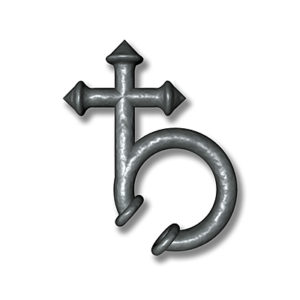
Saturn or lead represents the first rupture of the prima materia, the initial expression of manifesting consciousness. This we can discern by looking at its esoteric symbol, a cross mounted atop a lunar crescent. In the pictorial representation the fourfold differentiation of elements latent in the prima materia are in a state of passive abasement and have not as yet succumbed to the influence of the lunar or feminine aesthetic and receptive force for the purging of psychic impurities. Moreover the insurmountable position of the four elements reveals that the formative force of Saturn or lead stands at the nethermost end of the ladder of consciousness. The metal lead, its passive expression, exhibits the qualities of heaviness, softness, toxicity and chaos whilst the planet Saturn, its active expression, is the farthest of the seven planets from the center of our solar system as well as the most ‘sluggish’ in terms of the time take to complete a revolution around the Sun (29.7 earth years). These exemplify an intrinsic condition both at odds and light years away from the ethereal qualities of incorruptibility, nobility, eternity and splendor embodied by the Sun and its golden metal.
From a spiritual and psychological perspective, Saturn or lead denotes the conscious dependence upon and identification with the detritus and dross of material existence. In the alchemical opus, the Saturnine formative force is rendered potent during the lesser circulation or creation of the ‘white stone’ and mediates necrosis or nigredo, a primary stage in which the base substance in the alchemist’s retort or alembic blackens and putrefies. On a psychological and spiritual level, this state of physical corruption denotes the inversion and turning inward of the senses. The seventh woodcut emblem from Basil Valentine’s Azoth series offers a pictorial depiction of this phase as an elderly man in an entombed state of decomposition. Perched atop his hands is a raven, a bird frequently used to symbolize necrosis or nigredo (The others are the skull and grave). Two winged entities, the man’s soul and spirit, are vividly portrayed in the act of absconding with his last breath.
The metal lead has been known to humanity since the sixth millennium bce. This we known from metal beads unearthed at the Neolithic settlement of Çatalhöyük in modern-day Turkey which date to about c.6400bce. Millennia afterwards, the ancient Egyptians explored the metal’s properties and their artificers designated minium, otherwise known as lead oxide, and litharge, the protoxide, suitable for use as pigments. They also worked with white lead or lead carbonate which was extracted by subjecting metal sheets to the evaporating fumes of vinegar. The classical Greeks, who obtained much of their lead from the smelting of silver ores, associated the metal to the Titan Cronus, or Father Time, the youngest of the children born to the preeminent deity of the sky, Uranus, and the Earth Mother, Gaea. To this Graeco-Roman god of the harvest we owe the contemporary conception of death as a grim reaper that razes lives with his scythe. Use of the metal became widespread during Roman times, when many of the emperors had it worked into pipes, coins and the system of aqueducts that nourished Rome with water for drinking, bathing and flushing sewerage. It is alleged that the first century Roman Emperor Titus had some fifty thousand or so men delivered to the Spain lead mines for the sake of laboring until they dropped dead from exhaustion.
Popularity of the metal doesn’t seem to have waned at all. During the Middle Ages its practicality was all too apparent in the construction of roofs, water tanks and in the synthesis of pewter. Seventeenth century alchemists and physicians were acutely aware of its use as a curative agent too. Many of them prepared a solution of lead acetate and potassium carbonate from which a metallic preparation known as the Magistery of Saturn was engendered. This became the basis for an alchemical precipitate called the Powder of Saturn which was supposed to relieve respiratory ailments like asthma and tuberculosis of the lungs. Nowadays, the physiognomy of highly insoluble and stable lead compounds makes the metal a perfect candidate for the sheathing of electrical wires, acid tanks, cable hangers, as well as the primary composition for the weights and cable coatings on marine vessels. Despite its established toxicity to the human nervous system and lethal nature, the metal is still used in batteries, glassware, automotive tire balancing, the coloring of ceramics, and for the manufacture of weights used by recreational divers.








